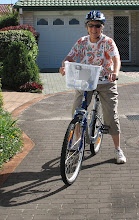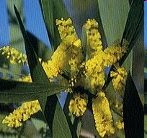
The Sydney Opera House can be mistaken for just any boat - depending on the angle of your view. Many types of craft move around her, adding to the impression.
In fact this beautiful building is situated on a small peninsular jutting into the harbour. The land is called Bennelong Point after one of the first Aborigines to become acquainted with the First Fleeters from Britain.
The point was originally the site of an Aboriginal midden or community gathering place and became one of the first areas from which this ancient race was dispossessed.
The surrounding precinct is one of my favourite parts of Sydney, my home town.

You can see Bennelong Point in this shot, as well as a trace of Mrs Macquarie's Chair and other parkland that extends quite a distance to take in the Sydney Botanical Gardens.
Large and very beautiful, Sydney has been a working harbour since the place was first settled by British people in 1788.
You could always count on seeing huge passenger and container ships, even warships, moving through the heads and past many of the harbourside suburbs.
There is about to be change however, with wharves soon to be abandoned and shipping moved to other ports. Right now there is much push and pull whether the sites will become parks or high rise.
I hope the greenies win!

Old restored and replica ships provide day trips for tourists and add to the colour of the harbour.

Of course visitors are everywhere. Here you can see the broad steps leading up to the Opera House proper.
It's as though the building is a giant set of monkey bars where visitors and locals climb and play - all over the site.
The Opera House is a real people place. Danish acrhitect Jorn Utzon did a remarkable job with this stunning creation.

Another icon, the Sydney Harbour Bridge, is a neighbour of the Opera House. As is this hotel that also carries maritime reminders.
I got confused with all of the angles in this shot - I can assure you that the tourists who stay at this resort do have level floors on which to walk! I think the result is fun anyway.

You can tour the bridge and climb high onto the arch for an astonishing view. Here you see tourists on their way aloft.

The bridge is a presence in many parts of the city. This is the northern end of George Street, I think the oldest thoroughfare in the city. Old wool stores in The Rocks area can be seen in the distance.
I'll take my bloggie mates on a tour of this area in the near future.

Nearby Circular Quay is another of my all time favourites. Here something is always happening.
Ferries dock and leave for suburbs in many areas of the harbour, buskers entertain and there is a constant flow of fascinating human beings.
This day was very grey and drizzling, but few let that bother them.

At first glimpse, this bright figure can be mistaken for a grandmother tending her littlies.

Hang around a little and we see that 'she' is a male busker - one of those who can stand stock still for astonishing periods. He waylaid a couple of little tourists (with parental permission) to take part in his show.

This news stand operator sees a lot of interesting sights every working day.

Captain Cook dropped in to say hello. He was promoting a cruise around the harbour.
Of course the Captain was the explorer who discovered eastern Australia for the British in 1770.
Only eight years later the government established the new colony as a gaol where they could get rid of their overflow of 'criminals', a large number of whom were transported for minor misdemeanours.
Many had stolen to survive and others were political prisoners. Others of course were murderers and villains through and through.

Coal miners were demonstrating about changes in their industry and came to the quay after a very large march through the city.

And then, of course, there were everyday Australian families enjoying themselves. These parents were tending their flock in a huddle that looked to me as though it could have belonged in a farm yard ...

These little guys enjoyed themselves so much they knocked themselves right out ...
Post Script: I have just learned that the architect of the Sydney Opera House Jorn Utzon today died in his sleep at his home in Denmark, aged 90.
Mr Utzon was involved in disputes with the New South Wales Government during construction of his wonderful building, and left the project in 1966, six years before it was completed. He never returned to Australia and never saw his work once it was finished. He always said he wasn't bitter about the experience.
In 1999, the Opera House invited Mr Utzon to prepare a statement of design principles for future changes to the building. Burying the troubles of the past, he agreed to work on the project as a consultant with his son and partner Jan.
In 2003, at the age of 85, Mr Utzon was recognised by his peers and awarded the prestigious Pritzker Prize, regarded as the Nobel Prize of architecture.
On the eve of the Sydney Opera House's 30th birthday in 2003, Mr Utzon sent a video message to Sydney expressing his gratitude at being involved in the new building developments.
"My gratitude is from the heart," he said. "Thank you very much for giving me permission to work again on the House."
- Jorn Utzon, 2002
What is the favourite part of your home town? Can you share the memories with us? Just leave a comment ...
And don't forget the latest episode of my novel 'Paternity' on Journeys in Creative Writing! It's an Outback Australian story of a city journalist trying to find her father ...













































